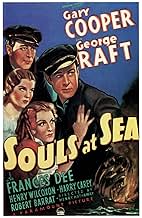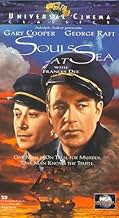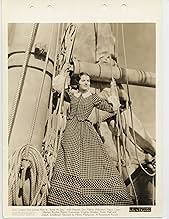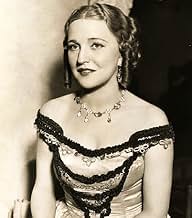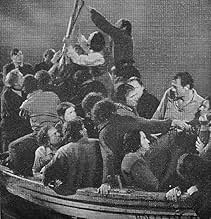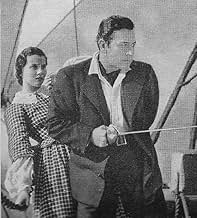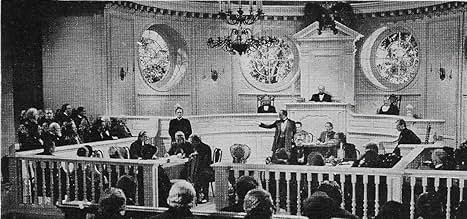PUNTUACIÓN EN IMDb
6,8/10
944
TU PUNTUACIÓN
Añade un argumento en tu idiomaCooper and Raft save lives during a sea tragedy in this story about slave trade on the high seas in 1842.Cooper and Raft save lives during a sea tragedy in this story about slave trade on the high seas in 1842.Cooper and Raft save lives during a sea tragedy in this story about slave trade on the high seas in 1842.
- Dirección
- Guión
- Reparto principal
- Nominado para 3 premios Óscar
- 3 premios y 3 nominaciones en total
Norman Ainsley
- Ticket Taker
- (sin acreditar)
Reseñas destacadas
Although not in the same lofty class as William Wyler, Alfred Hitchcock, Billy Wilder or Fred Zinnemann, Henry Hathaway remains one of my favorite Hollywood directors. I particularly like CALL NORTHSIDE 777, RAWHIDE and NIAGARA, but will quickly add that I found SOULS AT SEA a gem.
For starters, Gary Cooper and Frances Dee were at the height of their physical beauty, in addition to punching in terrific performances - Cooper always with a comic touch, Dee delightful in every nuance of her lovely eyes.
They are ably seconded by George Raft, Cooper's chum and a rather uneducated but senior shiphand who picks up some cultural pointers from Cooper and ends with sensitive, even sentimental moments.
Terrific enmical exchanges between Cooper and Henry Wilcoxon as Dee's devious brother. The two have issues over slavery, which the former actively sabotages and the latter sees as a major income opportunity.
Glorious B&W cinematography from Merrit Gerstad and Charles Lang, with terrific sequences at sea, notably as the little girl inadvertently starts a fire and the bad ship William Brown goes down.
The screenplay by Grover Jones and Dale Van Every includes some highly comic scenes, such as when Cooper, Dee and Wilcoxon all have hiccups at the same time, some very touching ones between Raft and love interest Olympe Bradna, and some very tragic decisions that Cooper has to make as the ship sinks.
Despite narrative ups and downs, the production values are very high, and the film remains engrossing throughout. 7/10.
For starters, Gary Cooper and Frances Dee were at the height of their physical beauty, in addition to punching in terrific performances - Cooper always with a comic touch, Dee delightful in every nuance of her lovely eyes.
They are ably seconded by George Raft, Cooper's chum and a rather uneducated but senior shiphand who picks up some cultural pointers from Cooper and ends with sensitive, even sentimental moments.
Terrific enmical exchanges between Cooper and Henry Wilcoxon as Dee's devious brother. The two have issues over slavery, which the former actively sabotages and the latter sees as a major income opportunity.
Glorious B&W cinematography from Merrit Gerstad and Charles Lang, with terrific sequences at sea, notably as the little girl inadvertently starts a fire and the bad ship William Brown goes down.
The screenplay by Grover Jones and Dale Van Every includes some highly comic scenes, such as when Cooper, Dee and Wilcoxon all have hiccups at the same time, some very touching ones between Raft and love interest Olympe Bradna, and some very tragic decisions that Cooper has to make as the ship sinks.
Despite narrative ups and downs, the production values are very high, and the film remains engrossing throughout. 7/10.
Gary Cooper (Nuggin) is on trial for manslaughter at sea. He is accused of playing God and deciding who lives and who dies on a sinking ship in the Atlantic Ocean. The verdict is pronounced and then George Zucco (Woodley) steps forward to give a statement and we head into flashback for the film's story. It is one that is set on the seas and involves slavery versus anti-slavery, romance and is partly a buddy-buddy movie with Cooper and his friend George Raft (Powdah). There is also tragedy and the story is based on an incident that set a precedent in maritime law.
It's an entertaining film with twists as to who is doing what so pay attention. It also has an interesting angle due to the legal significance of the story, and all the cast play their roles well. If you take note at the beginning of the film during the prosecutor's speech in the court case, he mentions some of those who didn't survive the tragedy. We will be introduced to these characters when the film moves onto the doomed ship.
Would you throw people out of a lifeboat to ensure the survival of at least some of them rather than the death of all of them? Every man for himself or do passengers come first? Why not just fly instead?
It's an entertaining film with twists as to who is doing what so pay attention. It also has an interesting angle due to the legal significance of the story, and all the cast play their roles well. If you take note at the beginning of the film during the prosecutor's speech in the court case, he mentions some of those who didn't survive the tragedy. We will be introduced to these characters when the film moves onto the doomed ship.
Would you throw people out of a lifeboat to ensure the survival of at least some of them rather than the death of all of them? Every man for himself or do passengers come first? Why not just fly instead?
It's a given that captains of cruise liners have a sworn duty to protect their passengers in case of any emergency, and their safety is paramount to any other concerns. Unfortunately, it hasn't always been the case. August 1937's "Souls at Sea," starring Gary Cooper, is based on the 1841 sinking of the 'William Brown,' a packet ship that hit an iceberg, sending its passengers scurrying into two lifeboats. Trouble was, one of the lifeboats became extremely overloaded, causing members of the ship's crew to toss some passengers over the side to avoid sinking the packed boat.
"This obscure film is so wonderful because (George) Raft and Cooper are dynamite together," gushed film reviewer Dennis Schwartz. "So who knew both laconic actors could be so animated and such a joy to watch together!"
Henry Hathaway directed this seafaring tragedy as Paramount Picture's version of MGM's 1935 "Mutiny on the Bounty." Cooper's character, Michael Taylor, is first seen in a courtroom listening to his verdict of guilty of murder for shooting at several desperate passengers clinging to the lifeboat. In the movie, the 'William Brown' sinks from a fire started by a young girl accidentally knocking over an oil lamp. Taylor takes charge of the lifeboat that's becoming swamped by too many survivors in the middle of the ocean. He feels he needs to take action or else everyone will drown. After the verdict was read, a British Navy official pointed out that his heroic actions on the lifeboat saved lives. He also added Taylor's work as an undercover abolitionist assisting the English in thwarting the illegal African slave trade to the United States should also be considered and the jurists should suspend his sentence.
"Souls At Sea" highlights details from the 1842 Supreme Court case United States vs. Holmes. After the 'William Brown' sinking where 12 passengers were forced out of the lifeboat by the ship's crew and drowned, only one crewman on the lifeboat, Alexander Holmes, was found in Philadelphia to stand trial. He was indicted for murder, but the jury came back with a less severe manslaughter verdict, sending the case all the way to the Supreme Court. The court ruled the crew's paramount duty was to the save the passengers, and if there were any life-threatening sacrifices to be made, the crew should go first.
"Souls at Sea" contains a flashback involving a series of romantic interests. Navy Lieutenant Stanley (Henry Wilcoxon), captain of the 'William Brown' secretly works for slave traders. Stanley and Taylor eventually come to blows, even though the abolitionist has fallen in love with the captain's sister, Margaret (Frances Dee). George Raft, as Taylor's buddy, Powdah, is also romantically linked to another woman on board, Babsie (Olympe Bradna).
One event related to "Souls at Sea" may have inspired the 1937 movie "A Star Is Born" which involved John Bowers. The former silent movie star, unemployed in Hollywood since 1931, was one of many actors unable to make the transition to sound. He had worked with Henry Hathaway in the past and knew the director was filming scenes for "Souls at Sea" off the shore of Catalina Island. Hoping to get a walk-in role, Bowers rented a small 16-foot sailboat to meet Hathaway, only to receive a firm rejection from him. He was last spotted sailing on his small boat away from the island, never to be seen alive. His body washed up on the Santa Monica beach, presumably from suicide, a fate Norman Maine suffered as he walked into the ocean at the conclusion of "A Star Is Born."
"Souls At Sea" was labeled 'artistically valuable' by the German government, one of the few Hollywood movies that Joseph Goebbels, the minister of propaganda, promoted for the increasingly restrictive country's movie import market. The Nazis' thinking followed the Aryan race philosophy that some groups of people had to be sacrificed for the good and the advancement of the German nation. The Paramount motion picture received three Academy Award nominations, including Best Assistant Director (Hal Walker) (in its last year as a category), Best Art Direction (Hans Dreier and Roland Anderson), and Best Music Scoring (Boris Morros).
"This obscure film is so wonderful because (George) Raft and Cooper are dynamite together," gushed film reviewer Dennis Schwartz. "So who knew both laconic actors could be so animated and such a joy to watch together!"
Henry Hathaway directed this seafaring tragedy as Paramount Picture's version of MGM's 1935 "Mutiny on the Bounty." Cooper's character, Michael Taylor, is first seen in a courtroom listening to his verdict of guilty of murder for shooting at several desperate passengers clinging to the lifeboat. In the movie, the 'William Brown' sinks from a fire started by a young girl accidentally knocking over an oil lamp. Taylor takes charge of the lifeboat that's becoming swamped by too many survivors in the middle of the ocean. He feels he needs to take action or else everyone will drown. After the verdict was read, a British Navy official pointed out that his heroic actions on the lifeboat saved lives. He also added Taylor's work as an undercover abolitionist assisting the English in thwarting the illegal African slave trade to the United States should also be considered and the jurists should suspend his sentence.
"Souls At Sea" highlights details from the 1842 Supreme Court case United States vs. Holmes. After the 'William Brown' sinking where 12 passengers were forced out of the lifeboat by the ship's crew and drowned, only one crewman on the lifeboat, Alexander Holmes, was found in Philadelphia to stand trial. He was indicted for murder, but the jury came back with a less severe manslaughter verdict, sending the case all the way to the Supreme Court. The court ruled the crew's paramount duty was to the save the passengers, and if there were any life-threatening sacrifices to be made, the crew should go first.
"Souls at Sea" contains a flashback involving a series of romantic interests. Navy Lieutenant Stanley (Henry Wilcoxon), captain of the 'William Brown' secretly works for slave traders. Stanley and Taylor eventually come to blows, even though the abolitionist has fallen in love with the captain's sister, Margaret (Frances Dee). George Raft, as Taylor's buddy, Powdah, is also romantically linked to another woman on board, Babsie (Olympe Bradna).
One event related to "Souls at Sea" may have inspired the 1937 movie "A Star Is Born" which involved John Bowers. The former silent movie star, unemployed in Hollywood since 1931, was one of many actors unable to make the transition to sound. He had worked with Henry Hathaway in the past and knew the director was filming scenes for "Souls at Sea" off the shore of Catalina Island. Hoping to get a walk-in role, Bowers rented a small 16-foot sailboat to meet Hathaway, only to receive a firm rejection from him. He was last spotted sailing on his small boat away from the island, never to be seen alive. His body washed up on the Santa Monica beach, presumably from suicide, a fate Norman Maine suffered as he walked into the ocean at the conclusion of "A Star Is Born."
"Souls At Sea" was labeled 'artistically valuable' by the German government, one of the few Hollywood movies that Joseph Goebbels, the minister of propaganda, promoted for the increasingly restrictive country's movie import market. The Nazis' thinking followed the Aryan race philosophy that some groups of people had to be sacrificed for the good and the advancement of the German nation. The Paramount motion picture received three Academy Award nominations, including Best Assistant Director (Hal Walker) (in its last year as a category), Best Art Direction (Hans Dreier and Roland Anderson), and Best Music Scoring (Boris Morros).
Souls at Sea (SAS) is an unusual film from Gary Cooper's peak years with Paramount Studios. It is obscure and hard to find. However, SAS is now available on YouTube, so those who are unfamiliar with it now have the rare opportunity to judge its merits for themselves.
SAS was originally planned to be a much more important film than the one we now have before us. Somewhere along the way, Paramount abandoned its ambitions for SAS. What eventually emerged, while hardly an epic, is an interesting entertainment that deals with important issues and deserves a larger audience.
The plot considers a back story involving the notorious slave trade that persisted into the nineteenth century, and the efforts by some individuals to take matters into their own hands to curtail the practice. But the more important part of the film deals with an unexpected shipwreck and the resulting inadequate lifeboat space available to accommodate its survivors. Cooper as the first mate faces the incredible dilemma of suddenly having to "play God" and determine which survivors must be sacrificed in an effort to save the lives of all the others.
This part of the story is based on fact. The actual case, U. s. v. Holmes, is a famous Supreme Court precedent known to anyone familiar with Criminal Law and the legal subject of homicide. Holmes, the first mate, was actually tried for manslaughter in connection with the deaths of those he consigned to die hoping to save the rest of the survivors. Was the defense of justifiable homicide available to Holmes under these facts? The legal answer was no. However, shortly after he had been found guilty of manslaughter, Holmes was freed from imprisonment. So what does the case stand for? Legal scholars argue about it to this day.
SAS presents the Holmes case in a fictional setting, yet it retains a similar ending. The Cooper character, now called Taylor, is set free after his trial. But the circumstances of this development may be more the result of his involvement in the back story of the plot than in the moral and ethical quandary of having to "play God" with the lives of innocent people to save others who might otherwise have perished.
For another take on the Holmes story, check out the Tyrone Power British film Seven Waves Away/Abandon Ship! (1957).
SAS has an extraordinary cast of supporting actors and splendid camera work--particularly in the climactic sequence involving the shipwreck. Cooper and George Raft make a surprisingly good "buddy" pairing, and SAS provides a rare opportunity to see the exotic beauty Olympe Bradna in one of her few Hollywood films.
All in all, SAS is a film that is well worth seeing, and deserves a wider audience than it now enjoys.
SAS was originally planned to be a much more important film than the one we now have before us. Somewhere along the way, Paramount abandoned its ambitions for SAS. What eventually emerged, while hardly an epic, is an interesting entertainment that deals with important issues and deserves a larger audience.
The plot considers a back story involving the notorious slave trade that persisted into the nineteenth century, and the efforts by some individuals to take matters into their own hands to curtail the practice. But the more important part of the film deals with an unexpected shipwreck and the resulting inadequate lifeboat space available to accommodate its survivors. Cooper as the first mate faces the incredible dilemma of suddenly having to "play God" and determine which survivors must be sacrificed in an effort to save the lives of all the others.
This part of the story is based on fact. The actual case, U. s. v. Holmes, is a famous Supreme Court precedent known to anyone familiar with Criminal Law and the legal subject of homicide. Holmes, the first mate, was actually tried for manslaughter in connection with the deaths of those he consigned to die hoping to save the rest of the survivors. Was the defense of justifiable homicide available to Holmes under these facts? The legal answer was no. However, shortly after he had been found guilty of manslaughter, Holmes was freed from imprisonment. So what does the case stand for? Legal scholars argue about it to this day.
SAS presents the Holmes case in a fictional setting, yet it retains a similar ending. The Cooper character, now called Taylor, is set free after his trial. But the circumstances of this development may be more the result of his involvement in the back story of the plot than in the moral and ethical quandary of having to "play God" with the lives of innocent people to save others who might otherwise have perished.
For another take on the Holmes story, check out the Tyrone Power British film Seven Waves Away/Abandon Ship! (1957).
SAS has an extraordinary cast of supporting actors and splendid camera work--particularly in the climactic sequence involving the shipwreck. Cooper and George Raft make a surprisingly good "buddy" pairing, and SAS provides a rare opportunity to see the exotic beauty Olympe Bradna in one of her few Hollywood films.
All in all, SAS is a film that is well worth seeing, and deserves a wider audience than it now enjoys.
Everything is excellent here. Gary Cooper makes one of his great character roles of double depths, George Raft makes for once a great contribution, all the characters are natural and organic, the realism is magnificent, the glory of the era of the sailing ships is enhanced and lifted out of the screen, and even the music is perfect, with many glorious moments of innovation and good humour, and the quality of the drama, both human and natural, is undeniable in its realisation with a formidable shipwreck to crown the masterpiece. Henry Hathaway knew his business thoroughly, he never committed mistakes, and this is just one of his many masterpieces.
¿Sabías que...?
- CuriosidadesWhen Nuggin and Powdah are in a tavern, the bartender immerses a hot iron into their beer mugs. This was most likely part of making a popular sailor's drink at the time called a "flip". It was made with beer, rum, sugar or molasses (and possibly a spice like cinnamon or cloves). The hot poker caramelizes the sugar. The technique was also just a quick way to warm beer during the winter.
- PifiasReading Hamlet aloud, Gary Cooper says, "the thousand natural shocks that the flesh is heir to." The second "the" is a mistake--it spoils the scansion.
- Citas
Michael 'Nuggin' Taylor: The floor of the ocean is paved with the bones of slaves.
- ConexionesReferenced in Dejad paso al mañana (1937)
- Banda sonoraSusie Sapple
(1937) (uncredited)
Music by Ralph Rainger
Lyrics by Leo Robin
Performed by George Raft and Gary Cooper
Selecciones populares
Inicia sesión para calificar y añadir a tu lista para recibir recomendaciones personalizadas
- How long is Souls at Sea?Con tecnología de Alexa
Detalles
- Duración
- 1h 32min(92 min)
- Color
- Relación de aspecto
- 1.37 : 1
Contribuir a esta página
Sugerir un cambio o añadir el contenido que falta

